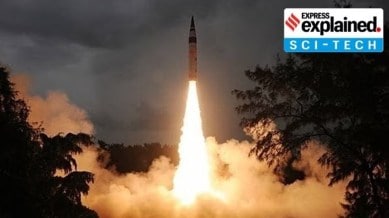PM Modi announces Mission Divyastra success: What is the Agni-5 missile with MIRV technology
Agni missiles have been in the arsenal of the Indian armed forces since the early 1990s. This latest variant of the Agni missile is equipped with MIRV technology. Here's what this means, and why it is significant.

India on Monday announced the successful testing of an Agni missile capable of carrying multiple warheads meant to hit multiple targets simultaneously. The success of Mission Divyastra, as the test was named, was announced by Prime Minister Narendra Modi.
“Proud of our DRDO scientists for Mission Divyastra, the first flight test of indigenously developed Agni-5 missile with Multiple Independently Targetable Re-entry Vehicle (MIRV) technology,” PM Modi tweeted.
What are Agni-5 missiles?
What is MIRV technology?
The MIRV can target multiple targets that can be hundreds of kilometers apart with a single missile. This Agni, capable of carrying nuclear warheads, has a range of more than 5,000 km, making it a long-range missile, and is aimed mainly at thwarting the challenge from China.
As of now, the United States, Russia, China, France and the United Kingdom are known to have MIRV-equipped missiles. These missiles can be launched from land or from sea from a submarine. While Pakistan is developing such a missile system, Israel too is suspected to either possess the missile or be developing it.
When was the Agni-5 last tested?
Agni-5 has been successfully tested multiple times since 2012. In December 2022, a successful flight test of Agni-5 was undertaken off the coast of Odisha.
Medium to Intercontinental versions of Agni missile systems 1 to 5 have varying ranges — starting from 700 km for Agni-1 to 5000 km and above for Agni-5. In June 2021, DRDO successfully tested Agni P, a canisterised missile with a range capability between 1,000 and 2,000 km. This means that the missile can be launched from road and rail platforms, making it easier for it to be deployed and launched at a quicker pace.
India announced the development of Agni V in 2007, and Avinash Chander, the architect of the Agni programme who went on to head the Defence Research and Development Organisation (DRDO), was quoted as saying that the next Agni variant “would be a multiple warhead missile with a capacity to carry four to 12 warheads.”
After the first successful flight test of Agni V in April 2012, then DRDO director general V K Saraswat said India was working on MIRV. “Basic vehicle will remain the same. The first three stages will also remain the same and only the kill vehicle or the payload delivery system will need changes… If I am able to do force multiplication with this… where I was using four missiles, I may use only one missile. So it becomes a force multiplier given the damage potential,” he said.
Researchers Joshua T White and Kyle Deming placed India’s pursuit of an MIRV programme in the context of the regional rivalry with China, and listed three perceived advantages for New Delhi. One, “preventing a widening imbalance in land-based ballistic missile forces”, since “India is believed to have at present only a limited number of missiles capable of targeting Chinese cities”. Two, “ensuring that India does not fall too far behind in its ability to establish a credible sea-based nuclear deterrent”, since “China has a more advanced program than India…for nuclear-powered ballistic missile submarines (SSBNs)”. And three, “some in New Delhi may…believe that MIRVs provide a hedge against the possibility that Beijing may someday decide to deploy BMD” (or ballistic missile defence system).
What makes MIRV technology specially lethal?
According to the Center for Arms Control and Non-proliferation, “In contrast to a traditional missile, which carries one warhead, MIRVs can carry multiple warheads. Warheads on MIRVed missiles can be released from the missile at different speeds and in different directions.”
The MIRV is also difficult to develop, which is why very few countries have them. “The development of MIRV technology is not easy. It requires the combination of large missiles, small warheads, accurate guidance, and a complex mechanism for releasing warheads sequentially during flight,” the Center for Arms Control and Non-proliferation said.
While the USA had the technology in 1970 and the Soviet Union followed suit in the same decade, since then, only a few countries have the MIRV capabilities, a club India has now joined.